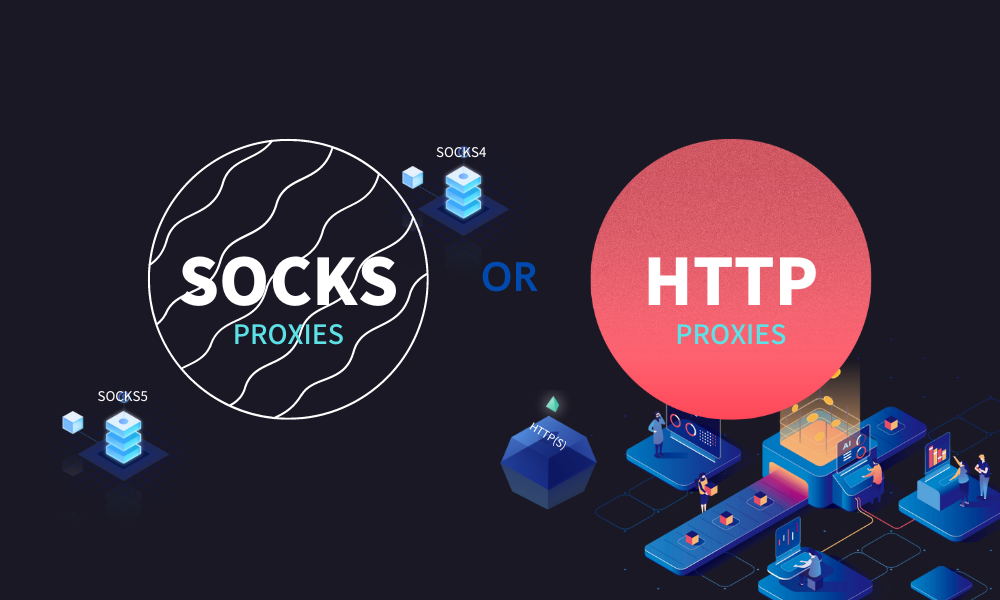Choosing Between SOCKS vs HTTP Proxy
Let's talk about the differences and similarities between SOCKS and HTTP, as well as the pros and cons of each. We will also cover the differences between SOCKS4 and SOCKS5.
Both SOCKS and HTTP are protocols for communicating over the Internet, but they serve different purposes.

HTTP is primarily used for web browsing and data transfer between web servers and clients.
SOCKS is a protocol that allows all kinds of network traffic to be sent between a client and a server, including web browsing, email, file transfers, and more.
One of the main differences between SOCKS and HTT is that SOCKS is a lower layer protocol that runs at the transport layer, while HTTP runs at the application layer.
This means that SOCKS can be used to tunnel any type of traffic, whereas HTTP is specifically designed to transfer data between web servers and clients.
In terms of advantages, SOCKS is generally considered more general than HTTP because it can be used in a wider range of applications. It also provides better security by allowing traffic to be encrypted and authenticated. However, SOCKS can be slower than HTTP due to the additional overhead of encryption and authentication.
HTTP, on the other hand, is faster and more efficient for web browsing and data transfer between web servers and clients. It's also easier to set up and use than SOCKS. However, it is not as secure as SOCKS because it does not provide encryption or authentication by default.
The advantages of the Socks protocol include:
Support various application programs: Socks protocol can support various network application programs, including Web browser, mail client and FTP client, etc.
Provide security and anonymity: Socks protocol can provide security and anonymity in different networks, can hide the real IP address of the client, and protect the privacy and security of data.
Support TCP and UDP: The Socks protocol can support TCP and UDP protocols, and can transmit various types of data in different networks.
Disadvantages of the Socks protocol include:
Does not support encryption: The Socks protocol does not support encryption, so other encryption methods need to be used when transmitting sensitive data.
Does not support authentication: Socks protocol does not support authentication, so there may be security risks.
Slower speed: Due to the need to go through a proxy server, the speed of the Socks protocol may be slower.
The advantages of the HTTP protocol include:
Simple and easy to use: The design of the HTTP protocol is simple and clear, easy to understand and implement, and can be conveniently used on different platforms and devices.
Strong flexibility: The HTTP protocol supports multiple data formats and transmission methods, which can adapt to different application scenarios and requirements.
Strong scalability: The HTTP protocol supports extended header information, which can easily add custom header information and functions.
Support caching: HTTP protocol supports caching mechanism, which can improve the efficiency and speed of data transmission.
Disadvantages of the HTTP protocol include:
Insecure: The HTTP protocol does not support encryption, and the transmitted data is easy to be eavesdropped and tampered with.
Low performance: The HTTP protocol adopts a request-response model, and each request needs to establish and disconnect, which will generate a large overhead.
Does not support state management: The HTTP protocol is a stateless protocol that cannot manage state information between the client and the server.
Does not support the push function: The HTTP protocol cannot actively push data to the client, and the client needs to continuously send requests to the server.
Now let's talk about the difference between SOCKS4 and SOCKS5. The main difference between the two versions is that SOCKS5 supports authentication and encryption by default, while SOCKS4 does not. This means that SOCKS5 is generally considered more secure than SOCKS4.
Socks4 and Socks5 are two different proxy protocols, the main difference between them lies in the following aspects:
Authentication mechanism: Socks4 protocol does not support authentication, but Socks5 protocol supports multiple authentication mechanisms, including username/password, GSS-API and DIGEST-MD5, etc.
Supported protocols: Socks4 protocol only supports TCP protocol, while Socks5 protocol supports TCP and UDP protocols.
Address type: Socks4 protocol only supports IPv4 addresses, while Socks5 protocol supports IPv4 and IPv6 addresses, and can be resolved through domain names.
Firewall and proxy: Socks5 protocol supports the connection of firewall and proxy server, and can establish a secure connection in different networks.
Overall, the choice between SOCKS and HTTP depends on your specific needs and use case. If you need to tunnel a wide range of network traffic and need strong security, then SOCKS may be a better choice. If you primarily need to transfer data between web servers and clients and prioritize speed and ease of use, then HTTP is probably the best choice for you. If you do choose to use SOCKS, SOCKS5 is generally considered the more secure and general choice.



















































